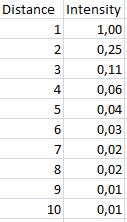Inverse Square Law
I mentioned it earlier and if you're interested in studio photography you'll probably have heard of it more often: The Inverse-Square Law. Sounds like science and as a matter of fact: it is. But don't let it scare you away! The "why" of the law is not important but you can get lot's of benefit of using it. In this article I try to explain in plain English what this law means and how it can be of use for you.
The inverse-square law (ISL) applies to all kinds of energy-sources but we'll focus on studio-light as in: off camera lighting. The Inverse Square Law tells us what the relative intensity of a energy source is according to the distance to the source.
If you have a light source and you measure the intensity of it at a distance of one meter this intensity will be 4 times bigger than when you measure it at a distance of 2 meter (at 2 meter, the intensity equals 1/(2x2) = 1/4 of the power).
To illustrate it a little better I give you this table:

What you see above is that the light fall-off in the first 3 steps is dramatic.
On the other hand: if you go further away from the light source the relative difference is small. If your model is at 9 (feet, meter, whatever) and your background is at 10, the difference between the intensity of the light on the model and the background is very small. In fact: this difference is so small you will not be able to measure the difference with your camera or light-meter!
So, imagine you want to make a (self-)portrait with a (near) black background, what would you do?
Place the model as close as possible to the light source and the background as far as possible from the light source. Of course. But: what distances are we talking about?
As I wrote in my article on my self-portrait in a tiny studio, the room I had was 1 by 1 meter. In fact, I was at a distance of 1 meter from the background. The distance between me and the light-source was about 0.3 meter. So:
the intensity of the light on me was 1/(0.3x0.3) = 11
the intensity of the light on the background was 1/(1x1) = 1
There was eleven (!) times more light on me than on the background!
If I set my camera to get me perfectly lit (and I did) the background will be allmost perfectly black (even if the cloth was white)!
I think this was enough theory for now.
The video below illustrates the theory very well:
If you want to know more on this topic I can recommend a search on Youtube.There are some pretty good videos that demonstrate the ISL!